
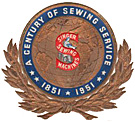


The Hidden Gems of Singer's 100th Anniversary
For over half a century what really happened during Singer's 100th Anniversary remained a mystery. There was an "Anniversary Model" sewing machine that went unnoticed with no advertising and no grand introduction. It was not mentioned in Singer's History timeline for the Centennial year. An extremely small quantity of these machines survived to this day but left owners with no idea of its true significance. Some would become rare and other's super-rare that are the Crown Jewel of Singer sewing machines to showcase the Centennial milestone. Luckily, tucked away for decades is an Anderson factory record, newspaper articles and other pertinent information that finally reveals the true story of the hidden gems of Singer's 100th Anniversary.
Made in 1951
It used to be a common belief that all "NA" serial numbered sewing machines were made in 1951. To this very day, if you call Singer's customer service they will tell you your "NA" serial number has a "Year of Issue" of 1951. This is because they have no Anderson factory records from 1952-1958 and with no choice but to use the misleading records from Elizabeth, New Jersey when they issued one million "NA" serial numbers, NA000001-NA999999, on 29 May 1951. Singer models 301, 301A, 401A and 403A all have "NA" serial numbers but were not manufactured until 1952, 1953, 1956 and 1958, respectively.
-
Up to March 1996 you could call Singer Customer Service with your serial number and they would give you a "Birth-Date" of 29 May 1951 for all "NA" serial numbers.
-
From April 1996 to 2005, Singer Customer Service used the Sewing Machine Blue Book dates of 1953-1959 for all "NA" and "NB" serial numbers. (The Singer 301A was made in 1953 and 1959 was when it was officially removed from Singer's Price List)
-
From 2005 to 2013, Singer Customer Service gives a "Year of Issue" for all serial numbers with: NA-1951, NB-1956, NC-1961.
-
Today, if you go to Singer's website they refer the Singer Sewing Machine Serial Number Database to the International Sewing Machine Collectors Society (ISMACS International). ISMACS lists Anderson Year of Issue for "Letter NA Series" 1951 to 1959, "Letter NB Series" 1959 to 1961 and "Letter NC Series" 1961 being the only one that is correct. Not only is most of it wrong it's useless.
Hopefully, Singer will use the "Dating Information" found on this website that give owners a correct "Year of Issue". Until then, the good news is the truth always has a way of revealing itself.
Elizabethport and Anderson Factory Records in 1951
Singer along with the Berlin-based agency "Culture Management Berlin", a joint licensing agreement, created a complete database of Singer sewing machine world productions beginning in 2000 and published in 2005. After over half a century, 1951-2005, we finally know what truly happened during Singer's 100th Anniversary.

Elizabethport factory original company register A2 log of "AK" Series Register Numbers
The Elizabethport factory "AK" Series Register Numbers shows that on 27 March 1951 Singer allotted a "Pilot Run" of 30 Singer Model 301 sewing machines, AK257721-AK257750. These 30 machines went through rigorous testing and inspection of parts for several months as it was an entirely new sewing machine. None of these 30 test machines have ever been located which means they were destroyed after testing.

Anderson factory original company register A2 log of "NA" Series Register Numbers
The Anderson factory "NA" Series Register Numbers shows that on 25 July 1951 Singer allotted a "Limited Production Run" of 10,000 Singer Model 301 sewing machines, NA000001-NA010000, as the "Anniversary Model" to commemorate Singer's 100th Anniversary. This was over a year before they were originally announced and released after its Grand Introduction in October 1952. The correct terminology in 1951 is "Singer 301 Limited-Production Anniversary Model" referred to as "Singer 301 Anniversary Limited Edition".
1,000, NA000001-NA001000, have a Blue Centennial Badge, "Singer 301 Centennial Limited Edition"
9,000, NA001001-NA010000, have the new Black Band Badge, "Singer 301 Anniversary Limited Edition"
The "Anniversary Model" to mark the company's 100th Anniversary!
Singer 301 Centennial Limited Edition
500 in Traditional Black and 500 in Soft Beige
Only "52" have been located and registered out of 1,000
"32" in Traditional Black and "20" in Soft Beige - All "Short Beds"
Serial Numbers: NA000001-NA001000
NA000008 Black - NA000017 Black - NA000018 Black - NA000019 Black - NA000048 Black
NA000050 Black - NA000064 Black - NA000074 Beige - NA000086 Black -NA000089 Black
NA000144 Beige - NA000153 Beige - NA000159 Beige - NA000176 Beige - NA000240 Beige
NA000242 Beige - NA000248 Black - NA000251 Black - NA000268 Black - NA000270 Black
NA000278 Black - NA000284 Black - NA000302 Black - NA000343 Beige - NA000365 Black
NA000409 Black - NA000420 Beige - NA000441 Black - NA000448 Black - NA000452 Beige
NA000453 Beige - NA000469 Beige - NA000514 Black - NA000522 Black - NA000536 Beige
NA000676 Black - NA000697 Black - NA000729 Beige - NA000732 Black - NA000745 Beige
NA000751 Black - NA000760 Black - NA000765 Beige - NA000801 Black - NA000813 Black
NA000857 Black - NA000867 Beige - NA000883 Beige - NA000907 Beige - NA000932 Beige
NA000975 Black - NA000989 Black
* * * * *
Note: Serial Numbers; NA000268-Black, NA000453-Beige, NA000801-Black, NA00975-Black and NA000989-Black have Centennial Serial Numbers but "Do Not" have a "Centennial Badge", instead, they have the new Black Band Badge. NA000420-Beige has the smaller Centennial Badge which is incorrect. Production Line Errors!
Note: NA001065-Beige, does not have a Centennial Serial Number but has a Centennial Badge.
Submit information about your Singer 301 Centennial Limited Edition
Singer 301 Anniversary Limited Edition
4,500 in Traditional Black and 4,500 in Soft Beige
Only "205" have been located and registered out of 9,000
"178 in Traditional Black and "27" in Soft Beige - (Black: "35" have Celtic Decal)
Serial Numbers NA001001-NA010000
Submit information about your Singer 301 Anniversary Limited Edition
Singer Celebrates 100th Anniversary
The Singer Manufacturing Company celebrates 100th Anniversary, marked by the issued patent of the first Singer sewing machine on August 12, 1851. To celebrate this milestone, they introduced the "Anniversary Model" as the new Slant-needle Singer Model 301 that would revolutionize the sewing-machine-of-tomorrow with a design to make home sewing easier and more convenient.
The new Slant-needle Singer 301 Anniversary Model and the original Singer sewing machine were on display at the Historical Collection exhibition of new and old Singer sewing machines in New York from 16-30 September during the 100th Anniversary of the patenting of the first Singer sewing machine.
The Historical Collection exhibition was also displayed during the month of November for the 100th Anniversary celebrated at the South Bend, Indiana factory where they crafted wood cabinets for Singer sewing machines.
Historical Collection Exhibition of New and Old sewing machines
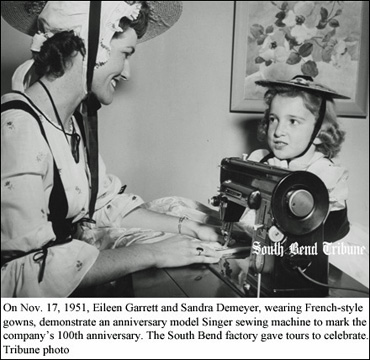
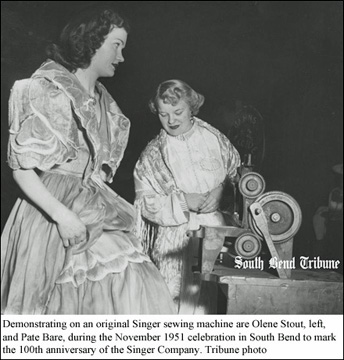
The new 1951 "Singer 301 Anniversary Model" The old 1851 "Original Singer Sewing Machine"
The new Slant-needle Singer 301 is the "Anniversary Model" to mark the company's 100th Anniversary.
Note: According to the editor for the South Bend Tribune; "The captions came from a special Singer 100th anniversary section the Tribune published in November 1951. The photo and captions were published in that special section."
After Singer's 100th anniversary this "Singer 301 Anniversary Model" was part of the "Historical Collection" in the Singer Archives, located in the Singer Building/Tower at 149 Broadway, New York City, New York. In 1967, the Singer Building/Tower was demolished and nobody knows what happened to this "Singer 301 Anniversary Model".
The New York Times, September 17, 1951
"Singer Plans Exhibit"
100th Anniversary of Patent to Be Marked This Week
The 100th anniversary of the patenting of the first Singer Sewing machine will be observed by the Singer Manufacturing Company at its recreation building here for two weeks, beginning tomorrow. The observance, a company spokesman said, will include exhibition of new and old sewing machines, demonstrations of a variety of unusual uses for sewing machines and exhibits of activities here.
The program will be given nightly, Monday through Friday, from 7 to 9 o'clock, with the 9,400 employees of the local Singer plant and their families attending on specific evenings. September 22 has been set aside for the Singer Veteran Employee Association, composed of retired and active workers on the company payroll for forty years or more.
Cooperating in the celebration is the Diehl in Finderne, N.J., a Singer subsidiary, whose employees are among the total of 20,000 to whom the company is expected to play host.
The Plaza, June 14, 1951
Singer Celebrates 100th Anniversary
New York, June 14: Representatives of press, radio and television today witnessed the growth of the Singer Sewing Machine Company over its first one hundred years and heard by Milton C. Lightner, company president, outline future plans.
A colorful documentary play staged in the ballroom of The Plaza portrayed how Isaac Meritt Singer built and patented the first practical sewing machine.
Pre-show exhibits demonstrated departmental activities of the company. Various techniques in teaching sewing and demonstrations of unique fashion stitches on Singer sewing machines. Models displayed costumes by Singer Sewing Centers in Burma, France, Morocco, Turkey, Mexico and Korea. The historical collection displayed the original Singer sewing machine and other Singer sewing machines from past decades. Industrial uses of the machine were illustrated by a wide range of end products ranging from a parachute to a doll's wig were shown. Displays of Singer vacuum cleaners, notions, thread and other sewing accessories sold in more than 1200 Singer Sewing Centers, and so much more.
Tomorrow (Friday) users of the industrial machines well be guest of Singer's Manufacturing Trade Department.
* * * * *
Your Invitation to Visit the Singer Archives
The original Singer Sewing machine and other Singer Sewing Machines from past decades displayed at the Centennial Celebration of this company June 14th at the Hotel Plaza are part of the historical collection in the Singer Archives, 149 Broadway, New York, New York.
This historical collection will be open for inspection by members of the press on Monday, June 18; Tuesday, June 19; Wednesday, June 20 and Thursday, June 21 from 10 A.M. to 4 P.M.
If you are interested in seeing this collection please sign and return the enclosed card.
In this collection you will view many interesting items connected to home sewing down through the ages and from all parts of the world. There is also an industrial display of Singer's part in war work.
* * * * *
Note: In June, the historical collection exhibition displayed the original Singer sewing machine and other Singer sewing machines of past decades. This is because the new Slant-needle Singer Model 301 was not allotted to be manufactured until 25 July 1951. During the 100th Anniversary celebrations in New York and South Bend, Indiana, the historical collection was changed to the exhibition of new and old sewing machines that displayed the new Slant-needle Singer 301 Anniversary Model (1951) and the original Singer sewing machine (1851).
1950 Chevrolet Sedan Delivery
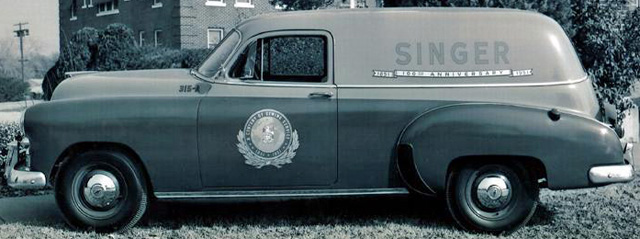
1950 Chevrolet Sedan Delivery
Photo courtesy of Bernard and his father who worked at Singer from 1948-1960
During the "Centennial Year" you would most likely see a "1950 Chevrolet Sedan Delivery" with the Singer Centennial emblem 100th Anniversary pull into your driveway to deliver a brand new Singer Model 301 sewing machine and sewing cabinet. This is an exceptionally rare photo of a 1950 Singer delivery vehicle.
Singer Centennial Badge

To commemorate Singer's 100th year anniversary Singer installed the Blue Centennial Badge, A Century of Sewing Service, 1851-1951, to Singer Model sewing machines allotted to be manufactured in 1951. Singer's original intent of the Centennial Badge turned into the biggest Marketing Gimmick in Singer's 100 year history.
The date of August 12th is used in Celebrating Singer's 100th Anniversary in 1951. Singer started the 1951 year as a normal year, there was no 100th year advertising nor were there any Centennial Badged sewing machines at Singer Sewing Centers. The only thing that happened in January and February were allotted batches of Singer sewing machines that would have a Centennial badge to commemorate the 100th Anniversary.
Singer's 100th Anniversary advertising campaign started in March 1951 at Singer Sewing Centers and in newspaper/magazine advertisements. This allowed the January-February allotted batches of Singer sewing machines manufactured in 1951 with Centennial Badges to be shipped to Singer Sewing Centers prior to the advertising campaign. Singer had no idea how customers would react to the 100th Anniversary and Centennial Badged sewing machines. This is understandable as prior "Special Badged" machines never made sales history.
In April, everything changed for Singer as the Centennial Badged machines were selling faster than anyone expected. On 26 April 1951 they allotted another batch of Singer series 15, 66, 128 and 201 sewing machines. The demand for these machines was great news for Singer but they had a major problem - Customers would not purchase any type of Singer sewing machine unless it had a Centennial Badge.
Singer had no choice but to change its original intent of the Centennial Badge into a marketing gimmick by installing the Centennial Badge on all old inventory of Singer model series 15, 66, 99, 128, 201, and 221 sewing machines dating from 1947-1950. Any old machine found at the factory now had a Centennial badge and was shipped to Singer Sewing Centers. All Singer Sewing Centers were instructed to install the Centennial Badge on any sewing machine with the standard Singer Gold Badge. In essence, Singer manipulated the sewing machines appearance by making a customer believe they were buying a new "Centennial" sewing machine made in 1951. What customers did not know was they were really buying an older sewing machine dating from 1947-1950.
This explains why some Singer sewing machines dating from 1947-1950 ended up having a Centennial Badge!
ISMACS Graham Forsdyke; When Singer introduced the Centennial range with the iconic anniversary badge, sales went through the roof and the Company rushed around the factory grabbing every machine they could find in an attempt to satisfy the dealers. This is not unique. There are cases of 1947 machines exiting the factory with the anniversary badge, but it's far from common.
The Centennial Badge was such a marketing success that it was included in the Singer History timeline;
Singer recovers from World War II when sewing machine production was
suspended, reaching $307.8 million in sales during its Centennial Year.
A True "Centennial" Singer Sewing Machine
The Centennial Badge was two-fold, its original intent to commemorate "Singer's 100th Anniversary" and as a "Marketing Gimmick" to reduce old inventory which left many owners, buyers, sellers and collectors asking the same question; Is the 1947-1950 and 1952 Centennial Badged sewing machine considered a true Centennial?
-
Singer had no choice but to change its original intent of the Centennial Badge into a marketing gimmick by installing the badge on old inventory. In essence, Singer manipulated the sewing machines appearance by making a customer believe they were buying a "Centennial" sewing machine made in 1951. Customers had no idea they were really buying an older sewing machine dating from 1947-1950.
-
Ironically, Singer stopped adding Centennial badges towards the end of 1951 as they felt a customer in 1952 would not purchase an older Centennial badged sewing machine.
-
Most owners and collectors feel the term "Centennial" is any machine that has a Centennial Badge regardless of when it was made and disregard the original intent of a "Centennial" Singer sewing machine. This of course was in regards to their own greed believing they own a true Centennial.
-
The original intent of the Centennial Badge was for Singer sewing machines that were allotted to be manufactured in 1951 to commemorate Singer's 100th Anniversary, thus ensuring it was "Made in 1951".
-
One could argue Singer sewing machines allotted in Oct-Nov 1950 that some were manufactured in 1951. It's possible, but without proof it becomes irrelevant. These same allotted batches have some with and without Centennial Badges. The ones with Centennial Badges were older machines in 1951 that Singer was unable to sell and Centennial Badges installed by the factory or Singer Sewing Centers.
-
A Centennial Badged sewing machines doesn't necessarily mean it's actually a Centennial. Over the years dealers used to remove Centennial badges from beat-up machines and install them on cleaner machines to add value. You could buy Centennial badges online and install them. This is especially true with pre-1951 machines and even more so if it has a 1951 purchase receipt. Not everything is as it seems.
-
ISMACS Graham Forsdyke; Unfortunately, Singer badges are easily removable from machines and I have heard of Centennial badges being added to late 1950 and early 1952 machines, 221 FW's in particular.
-
In 1951, would you buy a Centennial Badged sewing machine if you really knew it was made in 1947-1950 and was nothing more than an older sewing machines that has a badge with little intrinsic value?
-
The fact is a 1947-1950 Singer sewing machines with a Centennial Badge is a Singer sewing machine that has a Centennial Badge 1-4 years prior to Singer's 100th Anniversary in 1951, regardless if the badge was truly installed in 1951, it's still a 1947-1950 Singer sewing machine.
A true "Centennial" is any singer sewing machine that was undoubtedly allotted to be manufactured in 1951 and
has a Blue Centennial Badge, thus ensuring it was "Made in 1951" to commemorate Singer's 100th Anniversary.
Special Edition - Limited Edition - Anniversary Edition - Centennial Edition
Throughout Singer's history they have used "Special Badges" to designate special years and events:
Chicago 1933 - A Century of Progress / Chicago 1934 - A Century of Progress / 1836-1936 - Texas Centennial Exposition / San Francisco 1939 - Golden Gate Exposition / San Francisco 1940 - Golden Gate Exposition / 1851-1951 - A Century of Sewing Service / 1954 - State Fair of Texas / 1964-65 - New York World's Fair.
Instead of calling these machines by their correct nomenclature vintage groups, book writers, collectors and owners use the terms "Special Edition", "Limited Edition", "Anniversary Edition" or "Centennial Edition".
-
"Special Edition" implies they modify the design of an existing model with extra material of some kind included or a completely new version of something that differs from its original format or design. (Something other than installing a Special Badge)
-
"Limited Edition" is something that is limited in the numbers produced that will later become rare or scarce with some form of numbering system to verify how many were made. Just because a Singer sewing machine has a Special Badge does not make it a Limited Edition!
-
"Anniversary Edition" is something "new" to commemorate an anniversary and has a limited quantity with some form of numbering system to verify how many were made.
-
"Centennial Edition" is something "new" to commemorate a Centennial Anniversary and has a limited quantity with some form of numbering system to verify how many were made.
Singer used "Special Badges" to designate special years and events with one simple reason, to increase sales. They never kept any records to verify how many had special badges and never referred to any of these special badged sewing machines as a Special Edition, Anniversary Edition or Limited Edition.
This changed for the first time in Singer's 100 year history!
The "NA" Series Register Numbers shows on 25 July 1951 Singer allotted a "Limited Production Run" of 10,000 Singer Model 301 sewing machines, NA000001-NA010000, to commemorate Singer's 100th Anniversary. To celebrate this milestone, it was introduced as the "Anniversary Model" and displayed at the Historical Collection exhibition of new and old sewing machines. What Singer did use are the terms "Limited Production Run" referred to as a "Limited Edition" and "Anniversary Model" referred to as a "Centennial or Anniversary Edition".
The "Singer 301 Anniversary Model" is the only true
"Centennial Edition, Anniversary Edition and Limited Edition" in Singer's 100 year history.
The new Singer Model 301 is like having the Singer Model 201 and 221 combined!
The "only" sewing machine that's a cabinet and a portable model all in one!
The Best Sewing Machine Ever Made! The Worlds Finest Straight Stitch Sewing Machine!
The Singer 301 was undoubtedly the "Pinnacle" of all Singer Straight Stitching sewing machines!

The Making of a Super-Rare Sewing Machine
For the first time in Singer's 100 year history of making and selling sewing machines they decided to do something very special. Singer planned for a limited production run of 10,000 Singer 301 sewing machines as the "Anniversary Model" to mark the company's 100th Anniversary. Instead of them all having Centennial Badges they used the "Limited Edition" printmaking standards of 1,000 or fewer. Only the first 1,000, NA000001-NA001000, would have Centennial Badges, that's not all, there would be 500 in traditional black with gold decals and 500 in soft beige without decals, making them all very special "Singer 301 Centennial Limited Editions".
Bed-Arm Decal
Singer planned for the new Slant-needle Singer Model 301 in the traditional black to have "Paperclip" transfers or what we call decals. A "Paperclip Transfer" comes complete on one transfer sheet and all Singer sewing machines had matching transfer sets. What Singer did next was truly unique. On all Singer 301 Centennial Limited Editions in traditional black with paperclip decals Singer installed a nonmatching "Celtic Chain" decal on the back of the bed-arm instead of the matching "Paperclip" decal. There was absolutely no reason to do this for the first time in Singer's 100 year history unless they were trying to make a statement for us to figure out.
Singer intentionally used mismatched decals on the Singer 301 Centennial Limited Edition.
The printing department, located at the Elizabeth factory, is where all the literature is printed, along with badges and transfer sets used for ornamenting the machine heads. When Singer decided that only the first 1,000 Singer 301's manufactured would have Centennial badges the Elizabeth factory sent 1,000 Centennial Badges and 1,000 "Paperclip" transfer sets that included 1,000 "Celtic Chain" transfers for the bed-arm decal to the Anderson factory.
In reality, the Anderson factory only needed 500 transfer sets because 500 soft beige Centennials had no decals. This explains why the other 500 transfer sets with the Celtic Chain decal on the bed-arm were randomly found on "Singer 301 Anniversary Limited Edition" sewing machines with serial numbers NA001001-NA010000.
In 1951, the Singer Model 201 had matching "Paperclip" decals and the 221 Featherweight had matching "Celtic Chain". The Model 201 was full size and Singer's top of the line sewing machine. The Model 221 Featherweight was portable and Singer's best selling sewing machine. It is very clear that Singer cleverly made this unique change of mismatched decals on the "Singer 301 Centennial Limited Edition" as a way of saying that the new Slant-needle Singer Model 301 sewing machine is like having the Singer Model 201 and 221 combined.
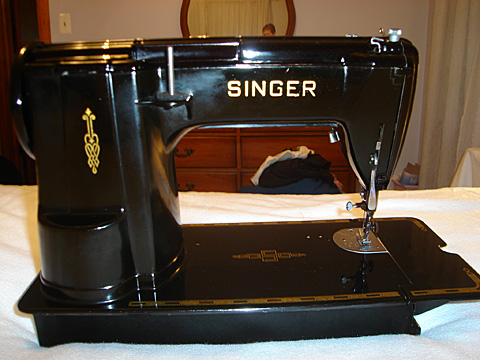
Celtic Chain Decal - Serial Numbers NA000001-NA001000
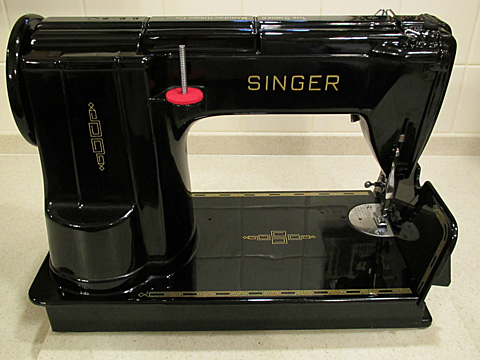
Paperclip Decal - Serial Number NA001001-NA130000
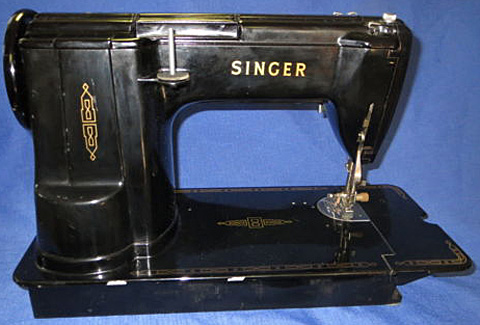
Prism Decal - Serial Number NA130001 to NB075000
Different Size Centennial Badges
Another unique change that really sets apart the "Singer 301 Centennial Limited Edition" is the Centennial Badge being larger in circumference than all other Singer sewing machines with a Centennial Badge. It is approximately 4/64" wider in width and 5/64" longer in length than the Centennial Badge used on Singer models 15, 66, 99, 128 and 201 sewing machines - the Singer Featherweight 221 of course is even smaller.
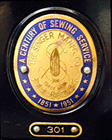
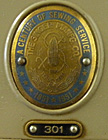
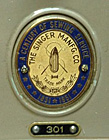
500 in Traditional Black 500 in Soft Beige Smaller Badge & Mounting Pins
Only 1,000 "Singer 301 Centennial Limited Edition" sewing machines have the larger Centennial Badge compared to all Singer sewing machines that had the smaller Centennial badge, making the 301 Centennial Badge very unique. The photo of a Centennial 301 with the smaller Centennial Badge is the incorrect Centennial Badge.
Short Bed Extension
In addition to the larger Centennial Badge and Bed-Arm Celtic Decal the "Short Bed Extension" was also unique. The "Singer 301 Centennial Limited Edition" can have one of three types; Style #1 without grids and without part numbers, Style #2 with one center grid and without part numbers, Style #3 no grids with part numbers.
Style #4 is the common short bed extension found on Singer Model 301's after the last Centennial, starting with serial number NA001001. It has 12 grids and part number "SIMANCO USA 170027". Singer could have easily installed this style on all Singer 301 Centennials as they were already manufactured but they didn't.
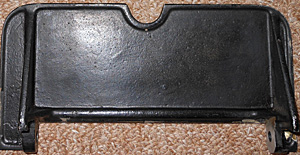
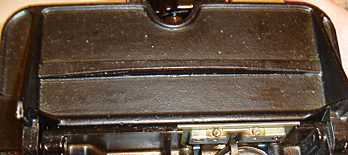
Two Styles (#1 & #2) found on the Traditional Black or Soft Beige Singer 301 Centennials
No Part Number Stamping
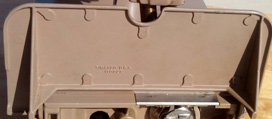
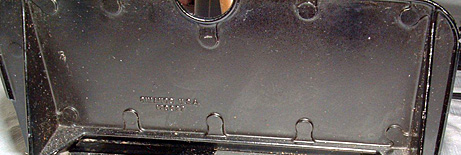
This Style (#3) was also found on the Traditional Black or Soft Beige Singer 301 Centennials
SIMANCO U.S.A. 170027
* * * * *

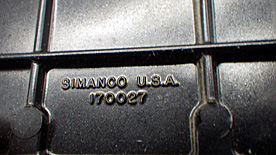
Common Style (#4) 301/301A Short-Bed Extension starting with Serial Number NA001001
SIMANCO U.S.A. 170027
According to the registry for Centennials with short bed extension; only 2 have Style #1, 4 have Style #2 with the majority having Style #3. This proves that all "Singer 301 Centennial Limited Edition" sewing machines have either of the 3 styles of short bed extensions that is different from the common style #4, making them all unique.
Three Unique Design Changes
Singer created three cleverly unique design changes that clearly shows they knew exactly what they were doing in making the "Singer 301 Centennial Limited Edition" in traditional black with gold decals into a unique "Special Edition" that went unnoticed for over half a century. They are a hidden gem and Crown Jewel of Singer sewing machines to showcase the milestone of Singer's 100th Anniversary.
The Super-Rare "Singer 301 Centennial Limited Edition" is a
"Centennial Edition, Anniversary Edition, Limited Edition and Special Edition", all in one!
The "Crown Jewel" of Singer sewing machine to showcase the milestone of Singer's 100th Anniversary!
* * * * *
Green Cover Instruction Manual
All "Singer 301 Anniversary Limited Edition" sewing machines were issued with a "Green Cover" instruction manual. The revised date of (1051) or October 1951 corresponds exactly when they were first sold. With only 10,000 instruction manuals printed they are "Super-Rare".
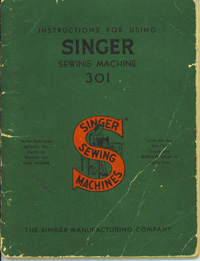
Singer 301 Green Cover Instruction Manual
Copyright 1935, 1936, 1938, 1940, 1947, 1948, 1950 and 1951: (1051), 60 pages
The First Singer 301 Instruction Manual
(1051) or October 1951 was the date of the first published manual
Only issued with a "Singer 301 Anniversary Limited Edition" sewing machine!
Singer Badge Boarder Casting
All "Singer 301 Anniversary Limited Edition" sewing machines have a border casting around the Singer Badge.
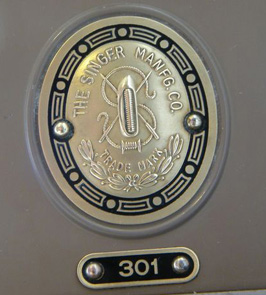
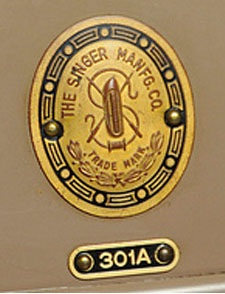
Border Casting No Border Casting
Motor "Circle S"
All "Singer 301 Anniversary Limited Edition" sewing machines will have a .53 amp Motor with a data plate that has the "Circle S", a "S" inside a gray circle, located on the left hand side. It will also have a silver lube tube.
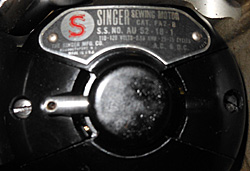

1951 Singer 301 "Circle S"
Foot Controller "Circle S"
All "Singer 301 Anniversary Limited Edition" sewing machines will have a 0.7 amp Foot Controller with a data plate that has a "Circle S" located in the center.
There were 2 foot controllers:
-
Part No. 194828 was issued with the Singer 301-1, for cabinet use. It consists of two separate wires. The first wire is called the line lead: one end has the electrical plug and the other end has the three pin female terminal housing. The 2nd wire is the controller lead: one end is connected to the foot controller and the other end has the 2-Pin male plug. You can easily tell this is for cabinet use, foot or knee.
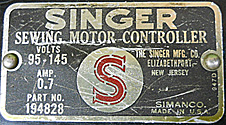
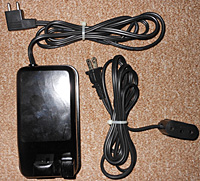
Part No. 194828 - 2 wires for cabinet use
-
Part No. 194584 was issued with the Singer 301-2, with trapezoid carry case. It consisted of only 1 wire, as we call it, with the foot controller on one end connected to the three pin female terminal housing and than connected to the wire with the electrical plug. You can easily tell this is for portable use.
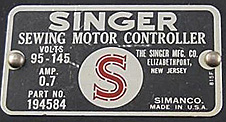
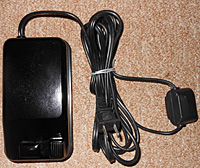
Part No. 194584 - 1 wire for portable use

The Crown Jewel of the Super-Rare
Only 500 were made in "Traditional Black" with the "Celtic Chain" decal on the back of the Bed-Arm

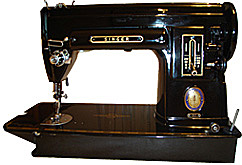

Super-Rare and Highly Collectable
The Super-Rare "Singer 301 Centennial Limited Edition" is a
"Centennial Edition, Anniversary Edition, Limited Edition and Special Edition", all in one!
What is the worth of a super-rare Singer 301 Centennial Limited Edition
Singer website on Machine Value: Machine can be worth a lot or a little, depending on a number of factors such as age, limited production runs, and condition.
In order to understand the worth of a super-rare Singer 301 Centennial Limited Edition the kinds of value must be taken into consideration:
-
Historical Value: A "Limited Production Run" of "500" were allotted to commemorate the 100th Anniversary with the Blue Centennial Badge, A Century of Sewing Service, 1851-1951. The Centennial Badges were larger in circumference than all other Singer sewing machines with a Centennial Badge.
-
The "Anniversary Model" at the "Historical Collection Exhibition" of new and old sewing machines during Singer's 100th Anniversary.
-
The only Singer sewing machine that is a Centennial Edition, Anniversary Edition, Limited Edition and Special Edition, all in one.
-
The only sewing machine that has the same number as the stitch type it sews - Stitch Type 301.
-
1st Slant-Needle sewing machine, making it easier to see what your sewing. Revolutionized the sewing-machine-of-tomorrow with a design to make home sewing easier and more convenient.
-
1st and only sewing machine that's a Cabinet and Portable model all in one. Full-sized, Full-fledged cabinet machine - that you can use as a portable. You can raise the handle and lift the machine out of the cabinet and carry it anywhere.
-
1st family sewing machine to sew up to 1,600 stitches per minute.
-
Decorative Value: Being the 1st Slant-Needle sewing machine shows the period style during the 100th Anniversary. The Traditional Black color with gold Paperclip decals with an unmatched Celtic Chain decal located on the bed-arm is a very rare occurrence.
-
Collector Value: Only 500 Traditional Black Centennials have the Blue Centennial badge of 1851-1951 with an extremely low quantity that exist today, rare and scarce.
-
Utilitarian Value: The Singer 301 was known as The World's Finest Straight Stitch Sewing Machine and as The Best Sewing Machine Ever Made.
-
Sentimental Value: Most owners of this super-rare sewing machine do not sell them, instead they pass from generation to generation. The personal and emotional association is greater than any other value.
-
Condition Value: The super-rare will always appreciate in value whatever the condition.
-
Monetary Value: The value of this super-rare sewing machine is not fixed. It holds every kind of value and them some. Monetarily, on any given day, it is what the seller asks and what the buyer is willing to pay.
-
Age Value: The super-rare will always keep increasing in value especially as it ages.
Collectors are always looking for that hidden gem. In recent years they found that the Super-Rare "Singer 301 Centennial Limited Edition" is a real collectors item as it holds every kind of value. They also know that when it becomes an antique the value will increase dramatically and why they are looking for them now.
Up until Singer's 100th Anniversary there has never been any model Singer sewing machine that was a Special Edition, Anniversary Edition, Centennial Edition or Limited Edition, however, some did have Special Badges installed that designated special years and events, that's all.
For the first time in Singer's 100th year history the "Singer 301 Centennial Limited Edition" is a Special Edition, Anniversary Edition, Centennial Edition and Limited Edition, all in one.
The "Crown Jewel" of Singer sewing machines to showcase the milestone of Singer's 100th Anniversary.
Owners of a "Singer 301 Centennial Limited Edition" will usually not even consider selling. These owners will most likely have the super-rare Green Instruction Manual, 301 accessories and because Centennials are short beds you may find an owner with an original No. 40 Queen Ann cabinet or another style cabinet sold in 1951, this increases the value significantly. If you are lucky to find an owner to sell be prepared to pay whatever the owner feels it's worth and they are worth more than you think.
How Super-Rare is it... Ask any Antique/Vintage Sewing Machine Collector if they have personally seen at least one "Singer 301 Centennial Limited Edition" and I can almost guarantee they will all say "No". They are virtually impossible to find but happy hunting and maybe you will be the next lucky owner of this super-rare machine.
ISMACS Graham Forsdyke regarding sewing machine value:
The "Super-Rare" will always appreciate whatever the condition.
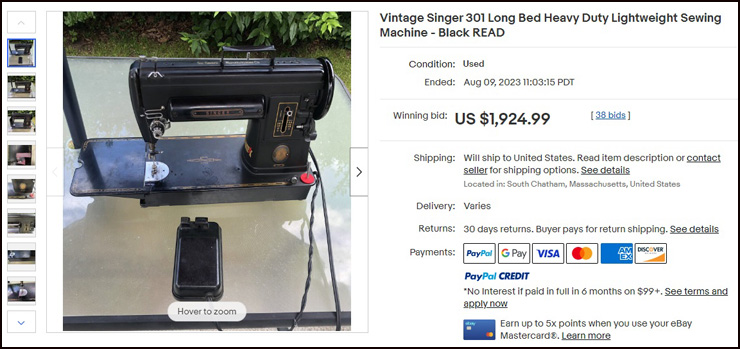
On 9 Aug 2023, this Singer 301 Centennial Limited Edition, serial number NA000813, was being auctioned as a parts machine and as is condition, Grade 1. To buyers it would be a Grade 4, poor condition but acceptable for a collection if a rare machine. The seller had no idea it was a super-rare machine. The short bed was changed to a long bed that had prism decals instead of paperclip decals. The shellac coating was coming off, it had major blemishes and scratches in the paint and the paperclip decals in the front of the machine were very worn. It had no Green Instruction manual or with any accessories and the foot controller was cracked on the bottom.
Even in very poor condition the winning bid was $1,924.99 and proves that Graham Forsdyke is correct regarding sewing machine value: The "Super-Rare will always appreciate whatever the condition. If a poor condition can sell for almost two grand and you add in the Super-Rare instruction manual that cost $300, if you can find one, plus all the accessories you are in the $2,500 price range, now add a better Condition Grade.
So what is the worth of a Condition Grade 8, what the average antique dealer would call "perfect", Singer 301 Centennial Limited Edition, in Traditional Black with Green Instruction Manual and Accessories. Historically, in 2015 one sold for $750, in 2017 one sold for $1,200, in 2018 one sold for $1,800, in 2019 one sold for $2,200, in 2020 one sold for $2,500 and in 2021 one sold for $2,800. In 2023, market value is in the $3,000 price range.
Monetarily, on any given day, it is what the seller asks and what the buyer is willing to pay. The one thing we know for sure is that the super-rare Centennial 301 will always keep increasing in value especially as it ages.
Singer 301 Centennial Limited Edition
Only 500 were made in Soft Beige (No Decals)

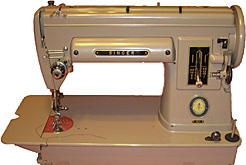

Super-Rare and Collectable
The Soft Beige "Singer 301 Centennial Limited Edition" are considered Super-Rare and Collectable but because of the color and modern appearance, without decals, they hold less value than in traditional black with decals.
In addition to the larger Centennial Badge and short bed extension with or without part numbers, we have also found that these Centennials can have either a "Black Carrying Handle" or "Soft Beige Carrying Handle" when purchased new in 1951.
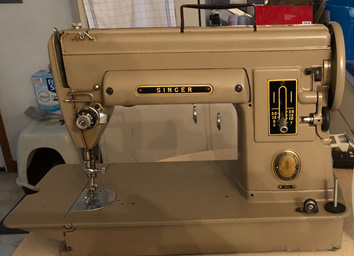
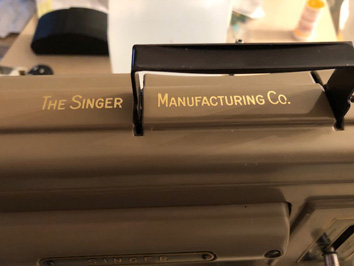
Soft Beige Centennial with Black Carrying Handle
Singer 301 Anniversary Limited Edition
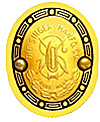
Rare and Collectable
There were 9,000 "Singer 301 Anniversary Limited Edition" sewing machines, serial numbers NA001001-NA010000, in both traditional black (4,500) and soft beige (4,500) all with the new Black Band Badge. They were the "Anniversary Model" during Singer 100th Anniversary in 1951.
The majority in traditional black have a Paperclip decal on the back of the bed-arm but there are some that have a Celtic Chain decal and increases its worth a little more than with the Paperclip decal. They are considered Rare and Collectable but worth much less than the "Singer 301 Centennial Limited Edition" because it did not have the Centennial Badge.
The soft beige are considered Rare and Collectable but because of the color and modern appearance, without decals, they hold less value than in traditional black.
Singer 301 Anniversary Limited Edition - Timeline
-
1950, Singer built a new plant/factory in Anderson, South Carolina to manufacture the Slant-needle series sewing machines.
-
27 March 1951, Elizabethport factory located in Elizabeth, New Jersey manufactured a pilot run of 30 Singer 301's with the following serial numbers: AK257721-AK257750. These 30 machines went through testing and inspection as it was an entirely new sewing machine.

-
29 May 1951, Elizabeth, NJ issued "NA" serial numbers, NA000001-NA999999, for the Singer 301, 301A, 401A, and 403A. Yes, 1 million serial numbers! The 301, 301A, 401A and 403A, all with NA serial numbers, were not manufactured until 1952, 1953, 1956 and 1958, respectively.
-
June 1951, plans for a limited production run of the new Slant-needle Singer Model 301 to commemorate Singer's 100th anniversary.
-
25 July 1951, the original Company register A2 log for the Anderson factory located in Anderson, South Carolina allotted a limited production run of 10,000 Singer Model 301 sewing machines, serial numbers NA000001-NA010000, to commemorate Singer's 100th Anniversary.

-
25 July-September 1951, the Singer Model 301 sewing machines are being manufactured at the Anderson factory. 1,000 with Centennial Badges, 500 in traditional black with gold decals and 500 in soft beige without decals. 9,000 with new Black Band Badge, 4,500 in traditional black and 4,500 in soft beige.
-
16-30 September 1951, the 100th Anniversary of the patenting of the first Singer sewing machine was observed by Singer Manufacturing Company in New York with 9,400 Singer employees. The new Slant-needle Singer Model 301 was displayed as the "Anniversary Model" at the Historical Collection exhibition of new and old Singer sewing machines.
-
October-December 1951, to celebrate this milestone, Singer quietly released a "Limited Edition" of 10,000 Slant-needle Singer 301 Anniversary Model sewing machines to be sold at Singer Sewing Centers with no advertising campaign or sales brochure. This corresponds with the first Green Cover Instruction Manual, copyright 1951, (1051), October 1951.
-
November 1951, the new Slant-needle Singer 301 Anniversary Model was displayed at the Historical Collection exhibition during the month of November for the 100th Anniversary celebrated at the South Bend, Indiana factory where they crafted wood cabinets for Singer sewing machines.
-
December 1951, the Singer 301 Anniversary Model is part of the Historical Collection exhibition in the Singer Archives, located in the Singer Building at 149 Broadway, New York City, New York.
-
October 1952, the Grand Introduction of the new Slant-needle Singer Model 301 sewing machine with an advertising campaign and an eight page, "The new Singer Model 301", sales brochure. Sincere's "History of the Sewing Machine" - In 1952, Singer marketed a machine that was a dramatic departure from the straight stitch machine of that day, the Model 301 Slant Needle.
* * * * *
My Personal Singer Collection



Super-Rare
NA000008 - NA000018 - NA000089 - NA000441 -NA000760
The Crown Jewels of my Collection
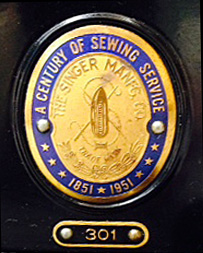
The Singer 301 Centennial Badge
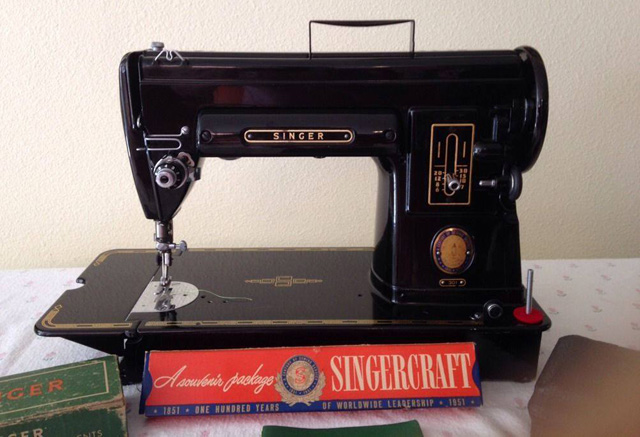
Singer 301 Centennial Limited Edition / NA000008
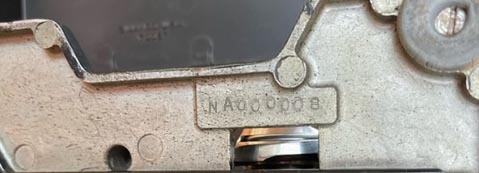
Of the Singer 301 Centennial Limited Edition's in my collection NA000008 is the most precious. Not only was it the 8th Centennial Limited Edition made in 1951 but over 70 years later is the earliest known Centennial to exist.

Serial Number NA009643 - Purchased on 12 December 1951
When I purchased this Singer 301 Anniversary Limited Edition it came with a No. 40 Queen Anne Cabinet and a Singer Chest. There was also a Singer warranty showing the purchase date and an index card showing everything that came with the machine and prices. It is a condition Grade 9, almost like the day it left the factory.
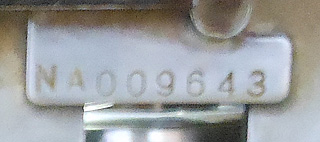
One of the last Singer 301 Anniversary Limited Editions made in 1951 - 9,643 out of 10,000
What this brand new "Limited Edition Singer 301" cost in December 1951
- Black Singer 301: $229.50
- Queen Ann #40 Sewing Cabinet: $74.00
- Sewing Stool: $26.00
- Sewing Chest 4 Drawer: $41.25
- Singer Buttonholer #160743: $9.95
- Centennial Singercraft Guide: Free
- Tax: $11.57
- Total: $392.27
- Less Singer Discount: -$45.00
- Grand Total: $347.27 on 12 December 1951 (Christmas Gift)
-
Included with 301 Sewing Machine: Green Cover Instruction Manual, Wiring Harness w/Foot Pedal, Metal Bobbin, Shuttle Case #45751, All Purpose Pressure Foot #170071, Seam Guide w/Screw, Singer 301 Sewing Machine Attachments #160623 - Box Includes: Multiple Slotted Binder #160624, Edge Stitcher #160625, Adjustable Hemmer #160626, Gather Foot #160628, Ruffler #160629, Black Felt Spool Washer, Black Screwdriver #25537, Tension Screwdriver #120378, 4 Bobbins, 2 Packs 15x1 Needles
The price was $229.50 in 1951. During the Grand Introduction in October 1952 it remained at $229.50. In 1958 the price was reduced to $169.90 to sell off the remaining inventory.
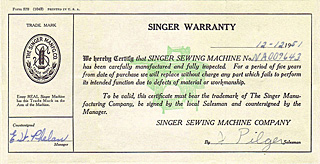
Singer 5 Year Warranty 12 December 1951
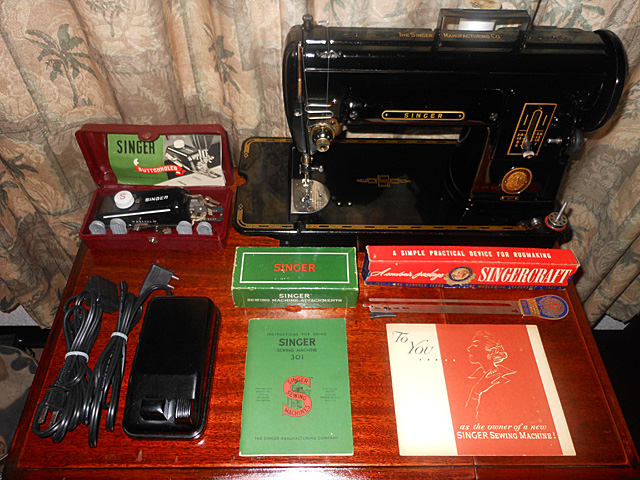
Singer 301, Green Instruction Manual, Singer Buttonholer, Singer Machine Attachments,
Centennial 1851-1951 Singercraft Guide, Foot Pedal and New Singer Owner Pamphlet
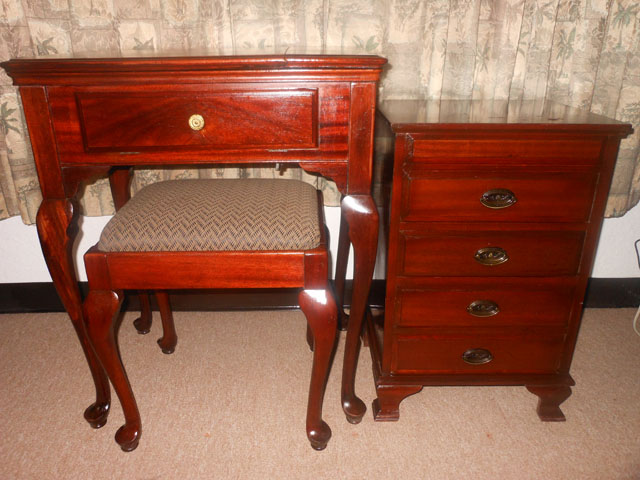
Queen Ann #40 Cabinet with Stool / Sewing Chest 4 Drawer / 1951

I was lucky to purchase this from a Singer employee for my collection!
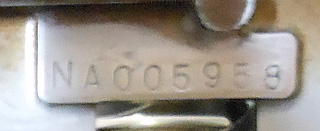
This Singer 301 Anniversary Limited Edition, NA005958, was awarded to a Singer employee with over 40 years of service during the 100th Anniversary. It also came with a Sterling Silver 100th Anniversary Singer Centennial Medal, Centennial Singercraft Guide, Grass Cloth Trapezoid Case, Green Cover Instruction Manual and all Accessories. It is a condition Grade 9, almost like the day it left the factory.
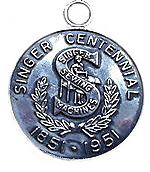
![]()
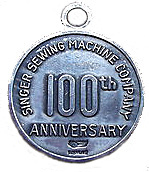
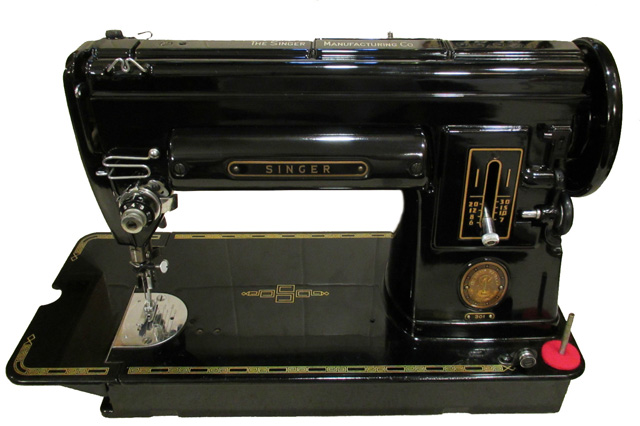
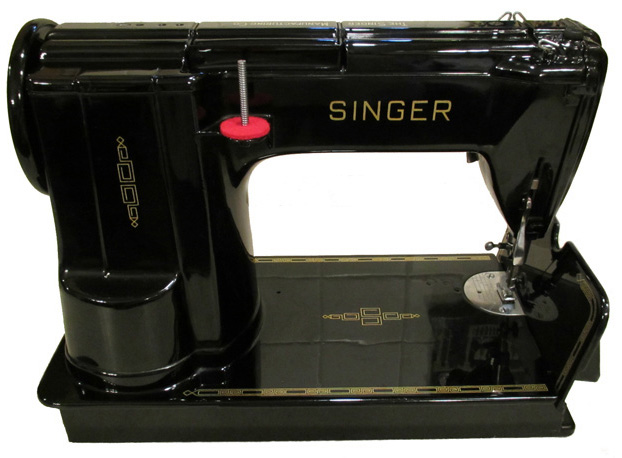
40 Years of Service Employee Award!
Super-Rare
Singer 301 Service Award Pin
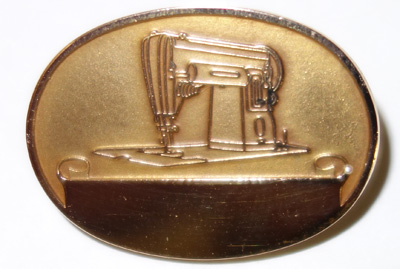
Singer Model 301 Service Award Pin
This is a Super-Rare Singer Model 301 Service Award Pin 1/20 10K GF. The area on the bottom is to engrave the employees name and other information. Very nice collectable item and only two are known to exist today.
* * * * *
Other Singer Sewing Machines in my Collection
Singer 201-2 Centennial
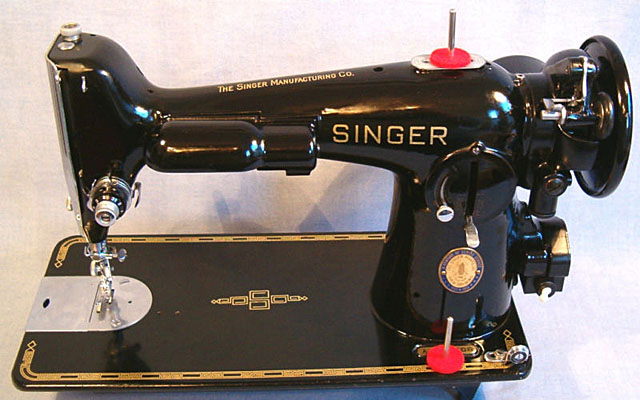
The Singer 201-2 Centennial shows the originality of the traditional sewing machine. It was Singer's top of the line and this one is a condition grade 9, serial number AJ956508, allotted to be manufactured on 6 November 1950. It has Paperclip decals that was used on the Singer 301 Centennial and Anniversary Limited Edition.
Singer Featherweight 221 Centennial
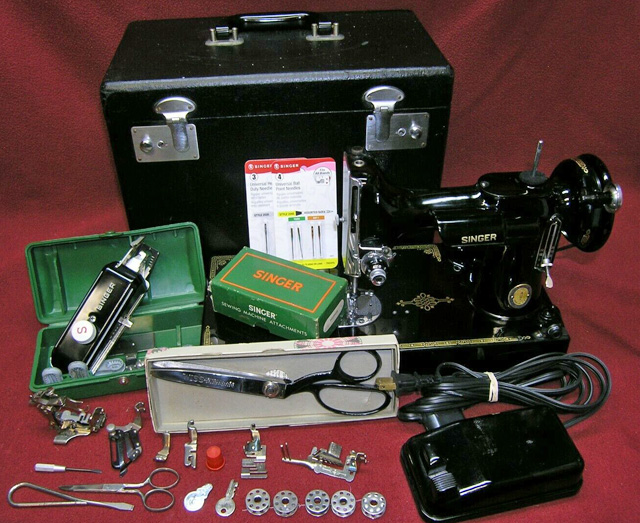
To complete my Centennial Collection is the Singer Featherweight 221 Centennial to show its portability. It was Singer's portable and best selling sewing machine and this one is a condition grade 8, serial number AK582780, allotted to be manufactured 31 October 1951. It has Celtic Chain decals with the Celtic decal on the side of its bed-arm that was used on the back bed-arm of the Singer 301 Centennial Limited Edition.
The unique change in decals was a clever way of Singer saying the Singer 301 Centennial Limited Edition was like have both the Singer 201-2 Centennial and Singer Featherweight 221 Centennial combined, but even better.
* * * * *
Singer Featherweight 221
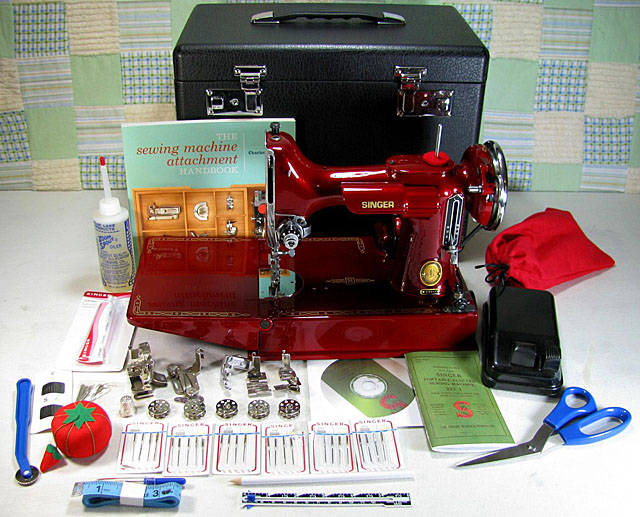
I purchased this 221 Featherweight custom painted candy apple red for my daughter. All girls need a sewing machine and this one made a perfect Christmas gift.
Singer Toy Sewing Machine No. 20
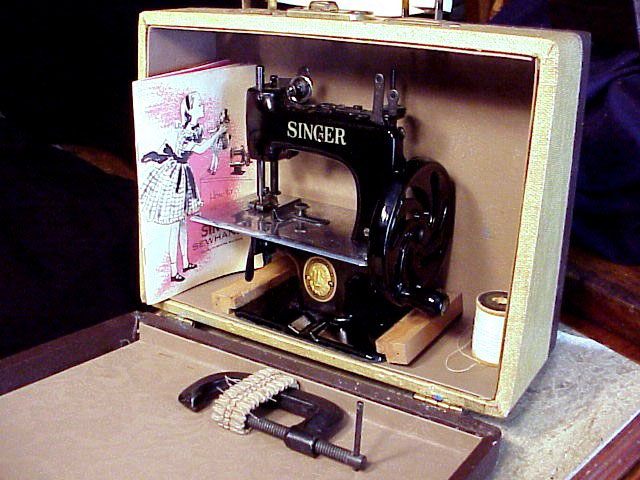
The Singer Toy Sewing Machine No. 20 (STSM). I have several dating from the 1910's to 1950's. They are cute and make wonderful decoration items. This one is special because it has the Singer 301 trapezoid case.
Other Singer Items from my Collection!
Very lucky to have collected all three styles of Singer 301 Tins that where produced.
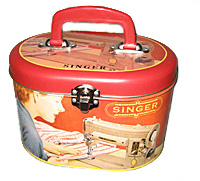
Vintage Retro Singer Model 301 Sewing Hinged Tin: made by Tin Box Company to store accessories, bobbins, thread spools, anything you want. Nice original retro image of the 1952 advertisement.
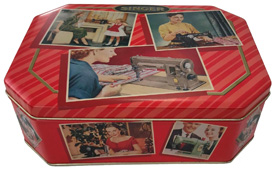
Singer Sewing Machines Vintage Images Retro Collectable Tin Hinged: made by McCall, this Singer sewing tin has all the collectable 1950's vintage images around the tin box but most importantly is the largest image of a Singer 301 from the 1952 advertisement.
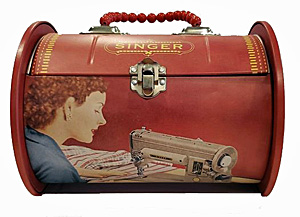
Vintage Retro Singer Model 301 Sewing Hinged Tin: no markings on who made this tin but inside are the markings "PAT NO 200530067140.2". On the bottom is a marking "Singer is a registered trademark of The Singer Company Limited or its affiliates. Copyright 2007. It has the 1952 Singer 301 advertisement and was made around 2007-2008.
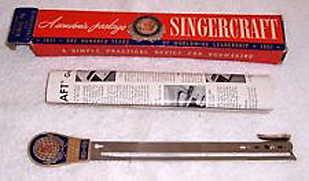
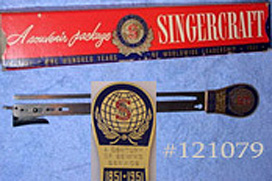
Centennial Singercraft Guide, #121079: Only issued during the Singer Centennial Year 1951. The guide itself is not marked with any number. It was a Special Edition of the Singercraft Guides and is the only #2 guide to have the design presented upside down as you sew. It was the very last Singercraft guide made. Discontinued in 1951
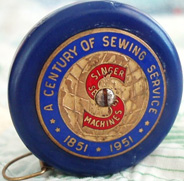
Centennial tape Measure: this is "A Century of Sewing Service" "1851-1951" tape measure. Very nice item to go with a Limited Edition or Centennial Singer 301.


Singer Centennial Medal: during the Centennial Year Singer presented to Employees a Sterling Silver 100th Anniversary Singer Centennial Medal. They are pretty hard to find but a very nice Centennial Collectors item.
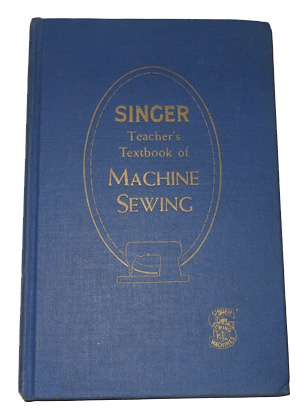
Singer Teacher's Textbook of Machine Sewing: This nice to have book shows how to use all your Singer sewing machine attachments. It also covers most of the vintage sewing machines and especially the Singer 301. Threading diagrams, cleaning and oiling. This book is filled with information. Copyright 1953 with the Singer 301 image on the front cover.
Thank you for visiting the Singer 301 website!